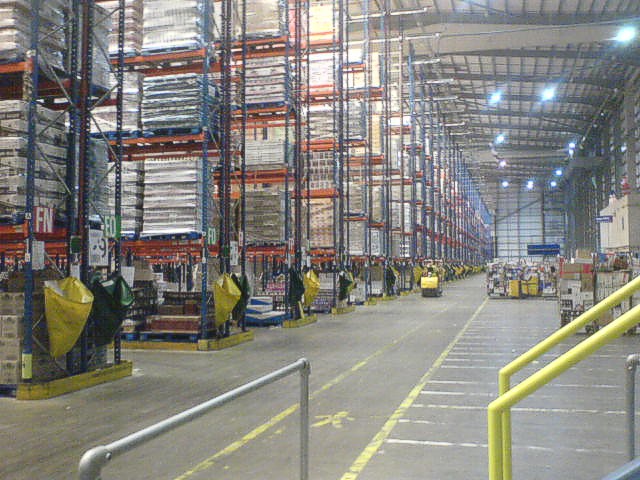
by Fronetics | Dec 23, 2014 | Blog, Manufacturing & Distribution, Supply Chain, Talent

As of late June 2014 there were 302,000 manufacturing job openings that were unfilled. These job openings are unfilled because employers cannot find qualified workers.
Pipe fitters, mechanical engineering technicians, welders, machinists, electronic assemblers, and operators of computer-numeric-controlled machines are the workers that are most needed. The problem is workers with these skills tend to be older and are at, or nearing retirement. According to Ben Dollar of Deloitte: “As workers retire, it’s becoming harder to find people with these traditional skills.” The Boston Consulting Group predicts that the number of job openings requiring these traditional skills will increase to 875,000 by 2020.
Companies with positions related to IT, software development, software engineering, and computer science are also struggling to fill positions (and get current employees up to speed). In an effort to help train the next generation of manufacturing talent, Siemens USA has donated more than $3 billion worth of manufacturing software to colleges over the past 18 months.
Eric Spiegel, Seimens USA CEO:
The digital world is coming very fast. There will be jobs. People may not count these jobs in IT and software development as manufacturing jobs, but they really are related to manufacturing.”
Seimens plans to fill 7,000 more people for these positions by 2020.
What positions is your manufacturing company struggling to fill?
What manufacturing job are you searching for?

by Fronetics | Dec 16, 2014 | Blog, Supply Chain

Is your distribution center proving to be a cost center? Looking to increase profits while reducing cost? Here’s how you can transform your distribution center into a profit center.
Synchronize
Anemic communication and fractured messaging within and across departments can be very costly. Build a culture in which exceptional communication in and between departments is a central component. Establishing clearly defined expectations and promoting openness will benefit your employees and your bottom line.
Optimize space
Take advantage of your distribution center. Every single inch should be used in a strategic manner. Empty or poorly used space will quickly transform your distribution into a cost center. Inspect your distribution center with a fine-toothed comb and a healthy dose of honesty. Identify obsolete inventory and work to eliminate it. Inventory that’s not necessarily obsolete, but might not be ideal for your company, should be matched with channels that will generate revenue for these products. Ensuring the optimization of space by eliminating unused and/or outdated inventory will play a significant role in turning your distribution center into a profit center.
Embrace technology
While the cost of purchasing technology may seem insurmountable, often the cost of not adopting specific technologies is even greater. Technology can serve to increase productivity, reduce error, and improve safety. Your customers will notice and appreciate it, too.
Invest in your employees
Attract excellent employees and cultivate them. Be willing to devote time and resources to your employees. Employee turnover is expensive. The cost of replacing an employee can range from 50 to 400% of their annual salary; it will serve you well to create an environment in which your employees want to stay.
Be flexible
Flexibility isn’t just essential to growth, it’s one of the vital elements to ensuring efficient day-to-day operations of your distribution center. When your distribution center is equipped to be able to process a wide variety of goods and SKUs, your distribution is more likely to be a profit center than a distribution center, which can process only a limited number of SKUs.
Scrutinizing every aspect of your distribution processes – from the buildings to what’s in them, and from the workers to how they work – will prove to be worth the investment of time and effort as all your hard work begins to pay off, and pay out.
Let us know what strategies have worked for you.

by Fronetics | Dec 16, 2014 | Blog, Supply Chain

Is your distribution center proving to be a cost center? Looking to increase profits while reducing cost? Here’s how you can transform your distribution center into a profit center.
Synchronize
Anemic communication and fractured messaging within and across departments can be very costly. Build a culture in which exceptional communication in and between departments is a central component. Establishing clearly defined expectations and promoting openness will benefit your employees and your bottom line.
Optimize space
Take advantage of your distribution center. Every single inch should be used in a strategic manner. Empty or poorly used space will quickly transform your distribution into a cost center. Inspect your distribution center with a fine-toothed comb and a healthy dose of honesty. Identify obsolete inventory and work to eliminate it. Inventory that’s not necessarily obsolete, but might not be ideal for your company, should be matched with channels that will generate revenue for these products. Ensuring the optimization of space by eliminating unused and/or outdated inventory will play a significant role in turning your distribution center into a profit center.
Embrace technology
While the cost of purchasing technology may seem insurmountable, often the cost of not adopting specific technologies is even greater. Technology can serve to increase productivity, reduce error, and improve safety. Your customers will notice and appreciate it, too.
Invest in your employees
Attract excellent employees and cultivate them. Be willing to devote time and resources to your employees. Employee turnover is expensive. The cost of replacing an employee can range from 50 to 400% of their annual salary; it will serve you well to create an environment in which your employees want to stay.
Be flexible
Flexibility isn’t just essential to growth, it’s one of the vital elements to ensuring efficient day-to-day operations of your distribution center. When your distribution center is equipped to be able to process a wide variety of goods and SKUs, your distribution is more likely to be a profit center than a distribution center, which can process only a limited number of SKUs.
Scrutinizing every aspect of your distribution processes – from the buildings to what’s in them, and from the workers to how they work – will prove to be worth the investment of time and effort as all your hard work begins to pay off, and pay out.
Let us know what strategies have worked for you.

by Jennifer Hart Yim | Dec 11, 2014 | Blog, Supply Chain
Note: This is a guest post written by Barbara Jorgensen, managing editor, Electronics Purchasing Strategies.
Barb has more than 20 years’ experience as a journalist, working for leading electronics industry publications such as Electronic Business, Electronic Buyers’ News and EDN. As a freelance writer, Barb wrote and managed an award-winning custom publication for Sager Electronics; was a leading contributor to Avnet Global Perspectives magazine; was a regular columnist for the National Electronics Distributors Association monthly newsletter and wrote for industry associations such as IPC. Barb was also a featured blogger on the B2B Website Allbusiness.com and helped launch Electronics Sourcing North America, a start-up magazine serving purchasing professionals in the Americas.
Prior to her freelance career, Barb was a senior editor at Electronic Business, the pre-eminent management magazine for the electronics industry, featuring world-class manufacturing companies such as Dell, Hewlett-Packard, Cisco and Flextronics International. Before joining EB for the second time, Barb spent 6 years with Electronic Buyers’ News as managing editor, distribution, winning several awards for coverage of the distribution beat. A graduate of the University of Binghamton, Barb began her journalism career with the Gannett newspaper chain. She has worked for a number of local newspapers in the Greater Boston area and trade journal publishers Reed Business Information and UBM.
Barb can be reached at [email protected].
Why supply and demand remain unbalanced, even in the connected world
With the advent of the internet and social media, it would seem that the supply chain has more opportunity than ever to collect and disseminate information. In the electronics industry, component makers, distributors and OEMs communicate in traditional ways: EDI, Excel, the internet, extranets, MRP/ERP systems and good old-fashioned e-mail; along with cloud-based platforms, Twitter, Facebook and other social media. It’s impossible to NOT be connected. 
Yet, component suppliers and contract manufacturers say that that OEMs’ ability to forecast is worse than it has ever been. OEMs still can’t predict their customers’ demand. Component suppliers—many of which have a minimum of 16-week lead times for production – often end up with too much product. Distributors pick up the slack, but as soon as inventory starts to build in the channel alarm bells go off. With so many opportunities for communication, how is this possible?
There are a couple of industry dynamics that could explain this. First, it’s been at least a decade since the electronics industry has seen any kind of significant shortage. Spot shortages cropped up following the Japan tsunami and Thailand floods of 2011, but nothing that could be termed industry-wide. Buyers have become accustomed to getting what they want when they want it. Moreover, the internet has made inventory and pricing information available to anyone with a search engine. Components appear to be available 24/7, 365 days a year. The urgency to forecast has diminished.
Then there is lean, just-in-time and build-to-order. All of these practices have effectively shortened the time between order and fulfillment. In practice, OEMs are working with an actual order – not a forecast – and the correct number of components is stored nearby. Lean has diminished the levels of inventory in the pipeline, so as long as everything is flowing as planned, there shouldn’t be any surprises.
Finally, the supply chain has figured out that it has to be more responsive and nimble regarding last-minute changes. In order to respond to JIT and BTO, inventories have to be maintained closer to manufacturing sites. Instead of single mega-hubs, suppliers and distributors have warehousing in key regions of the globe, and utilize third-party logistics when necessary. The ability to respond within 24 hours is a reality in most parts of the world.
So why are supply and demand in a state of perpetual imbalance? It’s not a dearth of data. Partners don’t necessarily trust the information they receive. Distributors routinely compare customer forecasts to historic orders to see if something is out of whack. Certain types of information are still withheld from partners: OEMs don’t share their preferred-pricing agreements with EMS. Online inventory is treated with a grain of salt: depending on how often data is refreshed, parts may or may not available at the price at which they are listed. Social media seems to be best used during disasters and for taking the pulse of market—what is trending and what is not.
Not sharing certain types of information is considered strategic by companies in the supply chain; and double-checking forecasts is a responsible business practice. However, these practices mean the supply chain may never be transparent. Information may be more available than ever, but visibility of data is an entirely different matter. Yet, even lack of information is no longer a problem in the supply chain, but full visibility remains elusive.

by Jennifer Hart Yim | Dec 11, 2014 | Blog, Supply Chain
Note: This is a guest post written by Barbara Jorgensen, managing editor, Electronics Purchasing Strategies.
Barb has more than 20 years’ experience as a journalist, working for leading electronics industry publications such as Electronic Business, Electronic Buyers’ News and EDN. As a freelance writer, Barb wrote and managed an award-winning custom publication for Sager Electronics; was a leading contributor to Avnet Global Perspectives magazine; was a regular columnist for the National Electronics Distributors Association monthly newsletter and wrote for industry associations such as IPC. Barb was also a featured blogger on the B2B Website Allbusiness.com and helped launch Electronics Sourcing North America, a start-up magazine serving purchasing professionals in the Americas.
Prior to her freelance career, Barb was a senior editor at Electronic Business, the pre-eminent management magazine for the electronics industry, featuring world-class manufacturing companies such as Dell, Hewlett-Packard, Cisco and Flextronics International. Before joining EB for the second time, Barb spent 6 years with Electronic Buyers’ News as managing editor, distribution, winning several awards for coverage of the distribution beat. A graduate of the University of Binghamton, Barb began her journalism career with the Gannett newspaper chain. She has worked for a number of local newspapers in the Greater Boston area and trade journal publishers Reed Business Information and UBM.
Barb can be reached at [email protected].
Why supply and demand remain unbalanced, even in the connected world
With the advent of the internet and social media, it would seem that the supply chain has more opportunity than ever to collect and disseminate information. In the electronics industry, component makers, distributors and OEMs communicate in traditional ways: EDI, Excel, the internet, extranets, MRP/ERP systems and good old-fashioned e-mail; along with cloud-based platforms, Twitter, Facebook and other social media. It’s impossible to NOT be connected. 
Yet, component suppliers and contract manufacturers say that that OEMs’ ability to forecast is worse than it has ever been. OEMs still can’t predict their customers’ demand. Component suppliers—many of which have a minimum of 16-week lead times for production – often end up with too much product. Distributors pick up the slack, but as soon as inventory starts to build in the channel alarm bells go off. With so many opportunities for communication, how is this possible?
There are a couple of industry dynamics that could explain this. First, it’s been at least a decade since the electronics industry has seen any kind of significant shortage. Spot shortages cropped up following the Japan tsunami and Thailand floods of 2011, but nothing that could be termed industry-wide. Buyers have become accustomed to getting what they want when they want it. Moreover, the internet has made inventory and pricing information available to anyone with a search engine. Components appear to be available 24/7, 365 days a year. The urgency to forecast has diminished.
Then there is lean, just-in-time and build-to-order. All of these practices have effectively shortened the time between order and fulfillment. In practice, OEMs are working with an actual order – not a forecast – and the correct number of components is stored nearby. Lean has diminished the levels of inventory in the pipeline, so as long as everything is flowing as planned, there shouldn’t be any surprises.
Finally, the supply chain has figured out that it has to be more responsive and nimble regarding last-minute changes. In order to respond to JIT and BTO, inventories have to be maintained closer to manufacturing sites. Instead of single mega-hubs, suppliers and distributors have warehousing in key regions of the globe, and utilize third-party logistics when necessary. The ability to respond within 24 hours is a reality in most parts of the world.
So why are supply and demand in a state of perpetual imbalance? It’s not a dearth of data. Partners don’t necessarily trust the information they receive. Distributors routinely compare customer forecasts to historic orders to see if something is out of whack. Certain types of information are still withheld from partners: OEMs don’t share their preferred-pricing agreements with EMS. Online inventory is treated with a grain of salt: depending on how often data is refreshed, parts may or may not available at the price at which they are listed. Social media seems to be best used during disasters and for taking the pulse of market—what is trending and what is not.
Not sharing certain types of information is considered strategic by companies in the supply chain; and double-checking forecasts is a responsible business practice. However, these practices mean the supply chain may never be transparent. Information may be more available than ever, but visibility of data is an entirely different matter. Yet, even lack of information is no longer a problem in the supply chain, but full visibility remains elusive.

by Fronetics | Dec 9, 2014 | Blog, Supply Chain

By spending time and money on unnecessary bells, whistles, and gimmicks in an effort to delight your customers, you may be cheating yourself out of creating real value for your customers. If your current focus isn’t on your internal customer workflows, it should be. Your customers will appreciate it and you’ll benefit from building more meaningful customer relationships.
Here’s how to delight your customers and start them on the path to becoming evangelists:
1. Make it easy for your customer to do business with you.
Focus all customer-related, post sale activity on making life easier for your customer to do business — more specifically, to do business with YOU. Start by identifying any bottlenecks or delays and then find a way to eliminate them. Talk with the customer. Ask about any challenges they experienced on their end – and respond accordingly. Be the provider that makes it easier for the customer to do business; making a customer’s business run smoother will trump bells and whistles anytime.
2. Empower your employees to respond to customer queries and requests.
Your customer-facing employees are critical to customer retention and satisfaction. Make certain your employees understand the importance of their roles and work to create a culture where employees are comfortable responding to customers. Ensuring employees have the necessary support and resources to confidently interact with your customers will build value that’s likely to boost customer satisfaction rates.
3. Invest in training.
Put your time and money into training with the objective of increasing No. 1 and No. 2 above. Smart, effective employees trump all other investments on the customer satisfaction and retention scale. Looking for proof? When was the last time you were upset with a company because they were smart and efficient?
4. Delight customers to increase revenue.
Keeping existing customers satisfied is the most economical way to grow sales revenue and profits because there are no customer acquisition or startup costs. Keeping existing customers satisfied should be the mantra of your frontline employees.
5. Listen to and learn from your customers.
Query customers about their experience, their current challenges, forecasted industry trends – anything that knowing the answer to might help you serve them better. Your questions might just lead to the discovery of a new pain point that could be the catalyst for the development of a new service offering. New service offerings create opportunities to delight current customers and attract new ones.
Remember, satisfied customers tell three friends about their experience, and angry customers tell their unhappy tale to dozens. These are the interactions that can make or break an organization.
We’d love to hear your stories of excellent or subpar experiences with your vendors. Let us know what happened.




